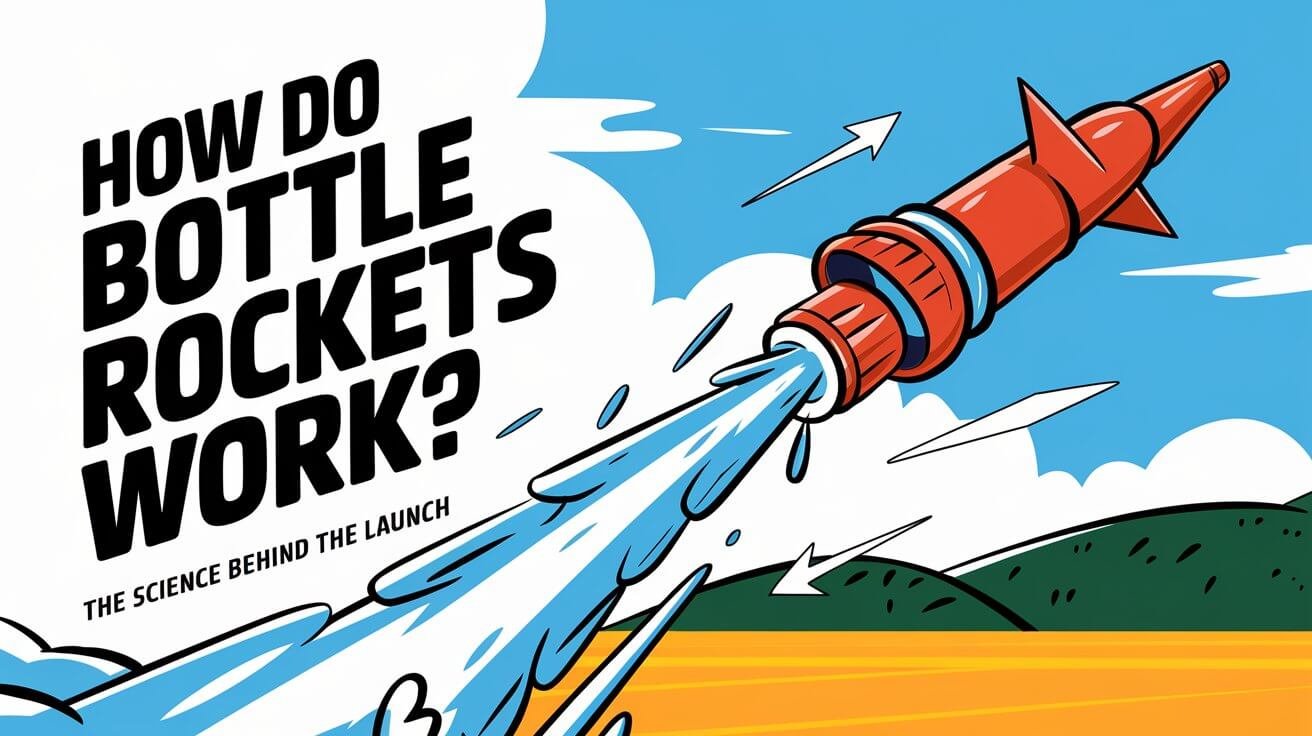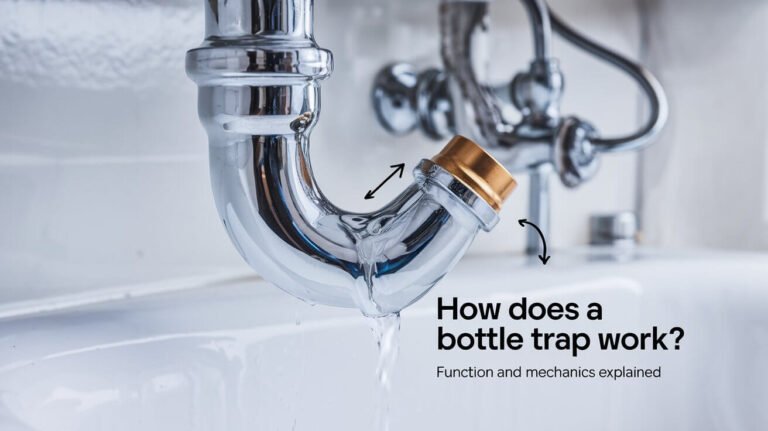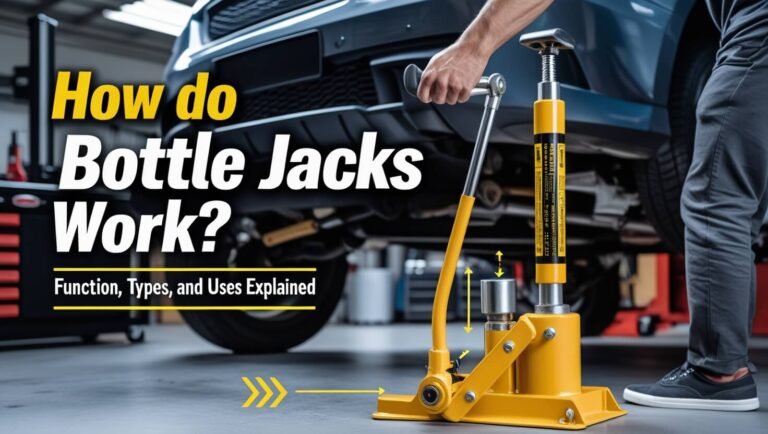How Do Bottle Rockets Work: The Science Behind the Launch

Ever wondered how bottle rockets fly? It’s all about physics. Thrust, gravity, and lift are key. By diving into bottle rocket science, we can learn how these objects take to the sky.
Wing design and small changes can affect how they fly. Bottle rocket science is full of interesting facts. Let’s explore the physics behind these flying wonders.
The Basic Physics Behind Bottle Rockets
Bottle rockets are a cool example of bottle rocket propulsion in action. They work because of pressure and propulsion. When launched, the air pressure inside the bottle pushes the rocket up.
The materials used in a diy bottle rocket matter a lot. The shape of the cone, the bottle size, and the bottle rocket materials used all affect how far it goes. For instance, a lighter bottle might go farther but isn’t as strong as a heavier one.
Newton’s Third Law in Action
Newton’s Third Law says every action has an equal opposite reaction. For bottle rockets, the action is the air pressure release, and the reaction is the rocket going up. This law is key to understanding bottle rocket propulsion.
Pressure and Propulsion Principles
The pressure inside the bottle propels the rocket. The water level in the bottle changes the pressure and how it moves. Trying different water-to-air ratios can find the best mix for the most efficiency.
Forces at Play During Flight
When flying, several forces act on the rocket. These include gravity, air resistance, and thrust. The rocket’s shape and materials affect air resistance, which changes its height and distance. Knowing these forces is important for making a good diy bottle rocket.
| Factor | Affect on Flight |
|---|---|
| Water level | Affects pressure and propulsion |
| Bottle shape | Affects air resistance |
| Materials | Affects durability and weight |
Core Components of a Bottle Rocket
A good bottle rocket design is key for a great flight. It needs a plastic bottle, a cardboard cone, fins, and a cork. These parts make a bottle rocket that can fly high with a bottle rocket launcher.
The bottle rocket design must be stable for a smooth flight. The fins keep it steady and on course. The cork builds pressure inside the bottle. When it’s released, the bottle shoots up, showing Newton’s Third Law in action.
When making a bottle rocket launcher, think about the bottle’s size and shape. Also, the fins’ material and the pump type matter. A well-made bottle rocket launcher can make the rocket fly even higher and farther.
Knowing the parts of a bottle rocket helps you build a fun one. You’ll have hours of enjoyment with your bottle rocket design and bottle rocket launcher.
The Science of Rocket Propulsion Systems
Understanding rocket propulsion systems is key for a successful bottle rocket experiment. The science behind it uses water as fuel, air pressure, and how thrust is made. These principles help people design and launch their own bottle rockets, learning about rocket science.
The thrust in a bottle rocket comes from Newton’s third law. When water is pushed out, the rocket goes up. The bottle, filled with gas up to 125 psi, helps make the rocket go higher.
Key Components of Rocket Propulsion Systems
- Water as a propellant
- Air pressure dynamics
- Thrust generation process
Learning about bottle rocket science and doing a bottle rocket experiment is fun. It teaches you about rocket systems. This knowledge lets you make better bottle rockets, exploring what’s possible.
Bottle Rocket Design Elements
When designing a bottle rocket, several key elements matter. The materials used, like the plastic bottle type, bottle rocket materials for the nose cone, and fins, all affect the rocket’s flight.
A good bottle rocket design considers weight, drag, and stability. For instance, a nose cone can cut down on drag, helping the rocket reach higher altitudes. The fins’ number and shape also influence the rocket’s stability and path.
Some important things to think about in bottle rocket design include:
- Using a minimum of 3 fins for stability
- Selecting a nose cone shape that reduces drag, such as a “Bertha Series” or “Egghead” shape
- Keeping the rocket as light as possible to achieve greater heights
- Adding weight to the nose of the rocket to enhance stability
By focusing on these bottle rocket design elements and choosing the right bottle rocket materials, you can make a rocket that flies high and stable. This makes for a fun and exciting experience.
Launch Pad Construction Techniques
Launching diy bottle rockets needs a solid and well-made launch pad. You can build a bottle rocket launchpad with basic stuff like a wooden board, corner irons, and screws. It should keep the rocket steady, with a small gap for the nozzle.
To make a launch pad, you’ll need:
- 1 x 3/4-inch wood board
- 12 3/4-inch wood screws
- 4 x corner irons
- 2 x 5-inch mounting plates
- 1 x rubber stopper
- 2 x spikes or tent stakes
- 3 x washers
A good launch pad gives your bottle rocket launchpad a solid base for a great launch. Always be careful and follow safety rules when launching diy bottle rockets.
| Material | Quantity | Description |
|---|---|---|
| Wood board | 1 | 3/4-inch thick, used as the base of the launch pad |
| Corner irons | 4 | Used to secure the wood board and provide stability |
| Wood screws | 12 | 3/4-inch, used to attach the corner irons to the wood board |
How Do Bottle Rockets Work: Step-by-Step Process
To grasp bottle rocket science, it’s key to learn the steps of how bottle rockets function. The process includes several important steps, such as:
- Launching the rocket by releasing the pressure built up inside the bottle
- Generating thrust through the propulsion system, which is typically water-based
- Stabilizing the rocket during flight using fins and a nose cone
Understanding how do bottle rockets work means knowing the physics behind their movement. The process turns the energy stored in compressed air into motion, pushing the rocket forward. By following these steps and grasping the bottle rocket science, you can make a bottle rocket that works well.
| Component | Importance |
|---|---|
| Fins | Stabilization during flight |
| Nose Cone | Aerodynamics and stability |
| Propulsion System | Generating thrust |
By learning the step-by-step process of how do bottle rockets work and the bottle rocket science behind it, you can see the complexity and beauty of these devices.
Stability and Aerodynamics
Stability and aerodynamics are key in bottle rocket design. A good design helps the rocket fly straight and withstand forces. The rocket’s shape and how it’s weighted also affect its thrust.
Stability and aerodynamics are very important. A rocket that’s not stable can’t fly straight and might crash. By focusing on these areas, you can make your rocket fly better. Key things to think about include:
- Fin design: The fins’ shape and size affect the rocket’s stability. Using three fins is common and works well.
- Weight distribution: The rocket should be evenly weighted for stable flight. Mixing heavy and light materials helps.
- Flight path optimization: The rocket’s path should be planned to reduce drag and increase range. Launching at an angle and using a parachute helps.
By paying attention to these factors, you can make a stable and efficient rocket. This will make your rocket fly better and safely. With a well-made rocket, you can reach great heights and distances, making it a fun hobby.
| Design Factor | Impact on Stability and Aerodynamics |
|---|---|
| Fin design | Greatly impacts stability, with three fins being a common design choice |
| Weight distribution | Should be evenly distributed to ensure stable flight |
| Flight path optimization | Should be optimized to minimize drag and maximize range |
Advanced Modifications for Better Performance
To improve your bottle rocket, try advanced tweaks. Focus on the materials used. Different folds and designs can balance lift and gravity, leading to better flights.
Consider making your rocket lighter and more streamlined. An elongated teardrop shape reduces air resistance. Also, a longer launch tube can help reach higher altitudes.
The amount of water affects your rocket’s performance. The right water volume depends on weight, drag, pressure, and nozzle size. Try different amounts and pressures to find the best mix. For example, a 1.5-liter bottle filled with an electric pump can work well.
Think about using multi-staged rockets for even higher flights. The timing of stage release is key. Adding a boat-tail can also cut down on base drag. These tweaks can elevate your project and deepen your understanding of physics and engineering.
Some key considerations for advanced modifications include:
- Optimizing weight and size for reduced drag and increased efficiency
- Streamlining the rocket body for minimal air resistance
- Using launch tubes to enhance apogee and altitude gain
- Experimenting with different water volumes and pressures for optimal performance
- Incorporating multi-staged designs for increased altitude and complexity
Variables Affecting Flight Distance
In bottle rocket science, knowing what affects flight distance is key. The water volume ratio is a big factor. It helps decide how far the rocket will go. Using the right amount of water makes the rocket travel farther.
Pressure levels are also vital in bottle rocket propulsion. The pressure inside the bottle before launch affects how fast the rocket goes. This, in turn, changes how far it flies. Things like air resistance and wind also play a part, affecting the rocket’s path and how well it does.
Here are some key things to think about to make your rocket fly farther:
- Water volume ratio: The ideal ratio of water to air in the bottle
- Pressure levels: The amount of pressure built up before launch
- Environmental factors: Wind, air resistance, and other external factors
By tweaking these variables, you can make your bottle rocket science and bottle rocket propulsion better. This leads to rockets that fly farther and do better. Here’s a table with some tips for better flight distances:
| Variable | Description | Optimization Tips |
|---|---|---|
| Water Volume Ratio | The ideal ratio of water to air in the bottle | Experiment with different ratios to find the optimal balance |
| Pressure Levels | The amount of pressure built up before launch | Use a pressure gauge to monitor and adjust pressure levels |
| Environmental Factors | Wind, air resistance, and other external factors | Launch in a controlled environment with minimal wind and air resistance |
Safety Protocols and Best Practices
Launching a bottle rocket requires careful attention to safety. A bottle rocket launchpad must be designed with caution. This is because a pressurized rocket can be dangerous. For example, a test with a one-liter bottle and a 20-pound watermelon showed how far debris can travel.
For those making diy bottle rockets, following safety guidelines is key. Here are some important tips to remember:
- Keep a safe distance of at least 15 meters (50 feet) from the launchpad
- Ensure the rocket’s weight does not exceed 1,500 grams
- Use launch ramps and launch tubes to support the rocket’s weight and attain higher speeds
- Deploy safety mechanisms such as parachutes, if possible
Building and launching a bottle rocket launchpad can be risky. It’s important to use common sense and follow safety rules. This way, people can enjoy making diy bottle rockets while staying safe.
| Safety Protocol | Description |
|---|---|
| Launch Distance | At least 15 meters (50 feet) from the launchpad |
| Rocket Weight | Not exceeding 1,500 grams |
| Launch Ramps and Tubes | Support the rocket’s weight and attain higher speeds |
| Safety Mechanisms | Deploy parachutes, if possible |
Troubleshooting Common Issues
When you do a bottle rocket experiment, you might face some problems. Knowing what these issues are can help you fix them. This way, you can have a fun and successful time with your rocket.
Stability is key for a good flight. It helps the rocket fly smoothly, not dive or spin out of control. Here are some things to think about to solve common problems:
Launch Failures
Launch failures can happen for a few reasons. These include low launch pressure, small nozzles, or the wrong foam propellant. For example, if the foam propellant is too thick or too thin, it can mess up the rocket’s flight. Try mixing different amounts of baby shampoo and water to find the right mix.
Flight Path Problems
Flight path issues can also occur. These might be because of uneven weight, bad fin design, or not enough launch pressure. To fix these, you can adjust the liquid inside the rocket, move the fins, or increase the launch pressure. These changes can make your rocket fly better.
| Issue | Possible Cause | Solution |
|---|---|---|
| Launch Failure | Low launch pressure | Increase launch pressure |
| Flight Path Problem | Uneven weight distribution | Adjust liquid levels or add weight to the nose |
| Pressure Leak | Improperly sealed nozzle | Check and reseal the nozzle |
By trying these tips and experimenting with different materials, you can make your bottle rocket experiment better. This will lead to a fun and successful experience.
Ending Thoughts
Exploring bottle rockets has shown us how important it is to understand their science. We’ve learned about Newton’s Third Law and how pressure and propulsion work together. These principles are what make bottle rockets so fascinating.
Our experiments have given us valuable data. We’ve seen how things like fin design and weight affect a rocket’s flight. By tweaking these details, we can make our rockets fly farther and straighter.
If you love science, enjoy tinkering, or just find physics cool, this article is for you. It’s packed with tips and knowledge to help you get the most out of bottle rockets. So, get ready to create, invent, and see just how far you can take your rocket. The sky’s the limit!
Good Questions
What is the basic principle behind how bottle rockets work?
Bottle rockets use Newton’s Third Law of Motion. This law says every action has an equal opposite reaction. When the water and air pressure are released, it pushes the rocket up.
What are the core components of a bottle rocket?
A bottle rocket has a few key parts. These include the bottle, the liquid propellant, the air pressure system, and fins for stability.
How does the rocket propulsion system work in a bottle rocket?
The system in a bottle rocket works by using water and air pressure. The air pushes the water out, creating a strong jet. This jet is what propels the rocket up.
What are the key design elements that affect a bottle rocket’s performance?
Several design elements impact a bottle rocket’s performance. These include the rocket’s shape and size, the materials used, and the fins. The rocket’s aerodynamics also play a role.
How do I build a safe and functional launch pad for a bottle rocket?
Building a safe launch pad for a bottle rocket requires careful planning. You’ll need a sturdy base and a release mechanism. It’s also important to ensure stability and control during launch.
What factors can affect the flight distance of a bottle rocket?
Several factors can influence a bottle rocket’s flight distance. These include the water volume ratio, pressure levels, and environmental conditions like wind and weather.
What safety precautions should I take when launching a bottle rocket?
Safety is key when launching a bottle rocket. Make sure to build a stable launch pad and wear protective gear. Also, choose a safe launch area with no obstacles or people in the way.
How can I troubleshoot common issues with my bottle rocket?
Troubleshooting common bottle rocket problems requires careful inspection. Check the rocket’s components and test the pressure system. Make adjustments to the design or launch process as needed.




